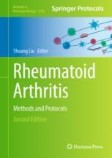Search
Search Results
-
β-arrestin2 deficiency ameliorates S-100-induced autoimmune hepatitis in mice by inhibiting infiltration of monocyte-derived macrophage and attenuating hepatocyte apoptosis
Autoimmune hepatitis (AIH) is a progressive hepatitis syndrome characterized by high transaminase levels, interface hepatitis,...

-
A Semiquantitative Protein-Fragment Complementation Assay to Study Protein-Protein Interactions of the Polymerase Complex in Cellula
Protein-fragment complementation assays (PCAs) are powerful tools to investigate protein-protein interactions in a cellular context. These are...
-
N-Glycan Insertion for Probing Protein–Protein Interactions and Epitope Map**
Introducing an N-linked glycosylation motif into recombinant proteins at specific sites is a useful tool in probing protein–protein interactions and...
-
Immunoprecipitation Followed by Mass Spectrometry: An Approach for Identifying Host–Viral Protein–Protein Interactions
As obligate intracellular parasites, viruses rely on the efficient manipulation of the cell they invade in order to multiply and spread....
-
The Split-Luciferase Complementation Assay to Detect and Quantify Protein–Protein Interactions in Planta
Protein–protein interactions play a critical role in plant viral infection and defense responses against pathogens. This protocol provides a detailed...
-
Protein Ubiquitination Assay
Ubiquitin, a 76-amino acid protein which could covalently bind to a target protein, is catalyzed by an enzymatic cascade comprising of ATP-dependent...
-
TurboID-Based Proximity Labeling: A Method to Decipher Protein–Protein Interactions in Plants
Proteins form complex networks through interaction to drive biological processes. Thus, dissecting protein–protein interactions (PPIs) is essential...
-
Prion Protein Conversion and Lipids
The conversion of α-helical rich normal prion protein to a β-sheeted pathogenic isoform is central to prion disease. Decades of studies provided...
-
Protein Misfolding Cyclic Amplification
Prion diseases are caused by a conformational conversion of the cellular prion protein (PrPC) to a pathological conformer (PrPSc). The “prion-only”...
-
Protein Nanocarriers for the Delivery of Phytoconstituents
Phytoconstituents are well known for their anticancer activities. They are considered as the best alternatives of chemotherapeutic drugs because of...
-
Co-Immunoprecipitation-Blotting: Analysis of Protein-Protein Interactions
Immunoprecipitation of protein complexes, also known as co-immunoprecipitation (Co-IP), is a powerful technique to analyze protein-protein...
-
Autoantibody Profiling Using Human Autoantigen Protein Array and AlphaScreen
Autoantibodies that recognize self-antigens are believed to have a close relationship with diseases such as autoimmune diseases, cancer, and...
-
Purification Process for a Secreted Protein Produced in Insect Cells
The Baculovirus Expression Vector System (BEVS) is used with cultured insect cells to produce a wide variety of heterologous proteins, which can be...
-
Nonviral Platform for Expression of Recombinant Protein in Insect Cells
Nonviral transfection has been used to express various recombinant proteins, therapeutics, and virus-like particles (VLP) in mammalian and insect...
-
Protein–Protein and Protein–RNA Interaction Assays to Determine Similarity of INI1/SMARCB1 and TAR RNA in Binding to HIV-1 Integrase
INI1/SMARCB1 is a host protein that interacts with HIV-1 integrase (IN) and influences multiple stages of viral replication. IN is a viral enzyme...
-
Controlling the protein corona of polymeric nanocapsules: effect of polymer shell on protein adsorption
Understanding the interactions between nanocarriers and plasma proteins is essential for controlling their biological fate. Based on the reported...

-
Assessing Protein Expression in Patient-Derived Xenografts Using Western Blotting
The use of patient-derived xenografts (PDXs) in cancer research is increasing due to their ability to closely mimic the features of patient tumors....
-
Performance of Chromogenic Protein C (PC) Testing
Protein C (PC) is a vitamin K-dependent zymogen synthesized in the liver that plays a major role in regulating the coagulation pathway. Upon...
-
Production of Immunizing Antigen Proteoliposome Using Cell-Free Protein Synthesis System
Antibodies specifically recognizing integral membrane proteins are essential tools for functional analysis, diagnosis, and therapeutics targeting...
-
Protein Structure and Modification of Aquaporins
Aquaporins (AQPs) allow water molecules and other small, neutral solutes to quickly pass through membrane. The protein structures of AQPs solved by...
